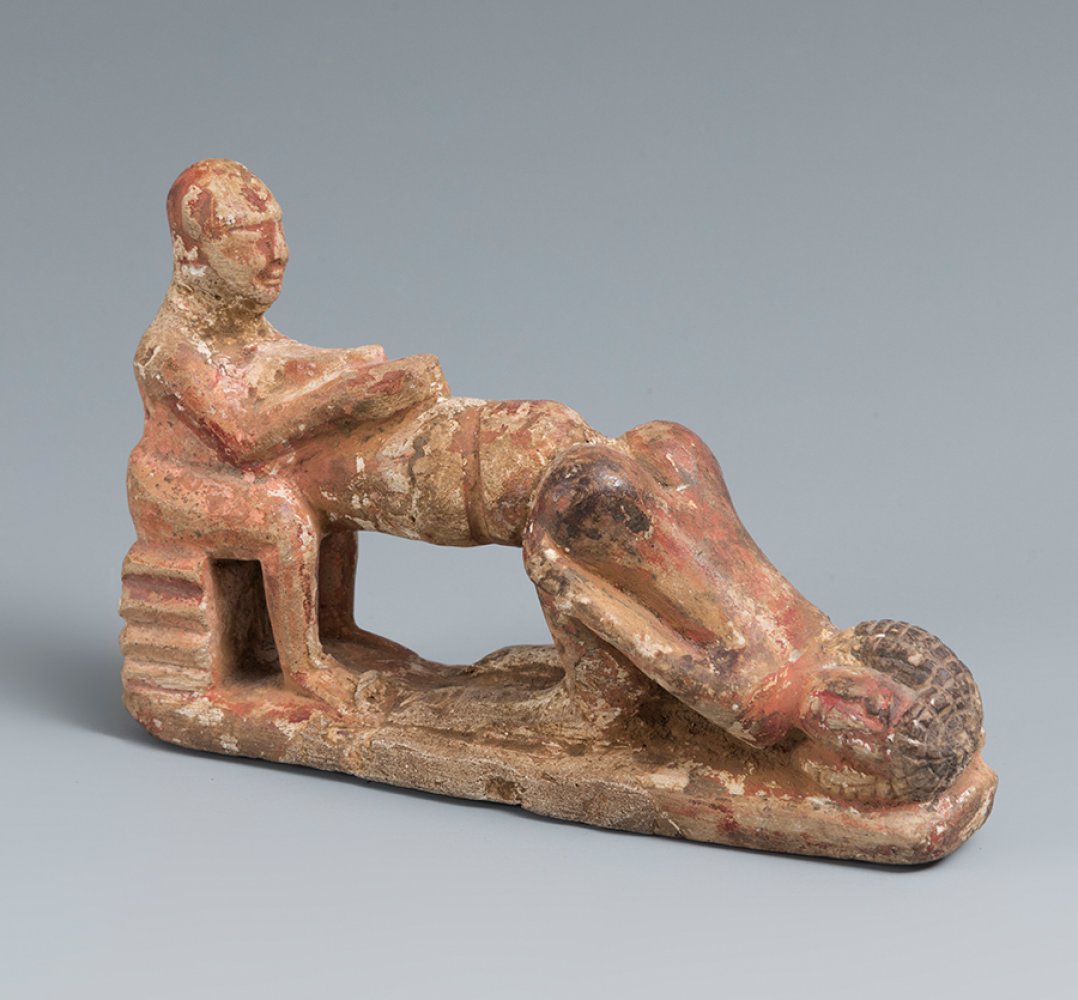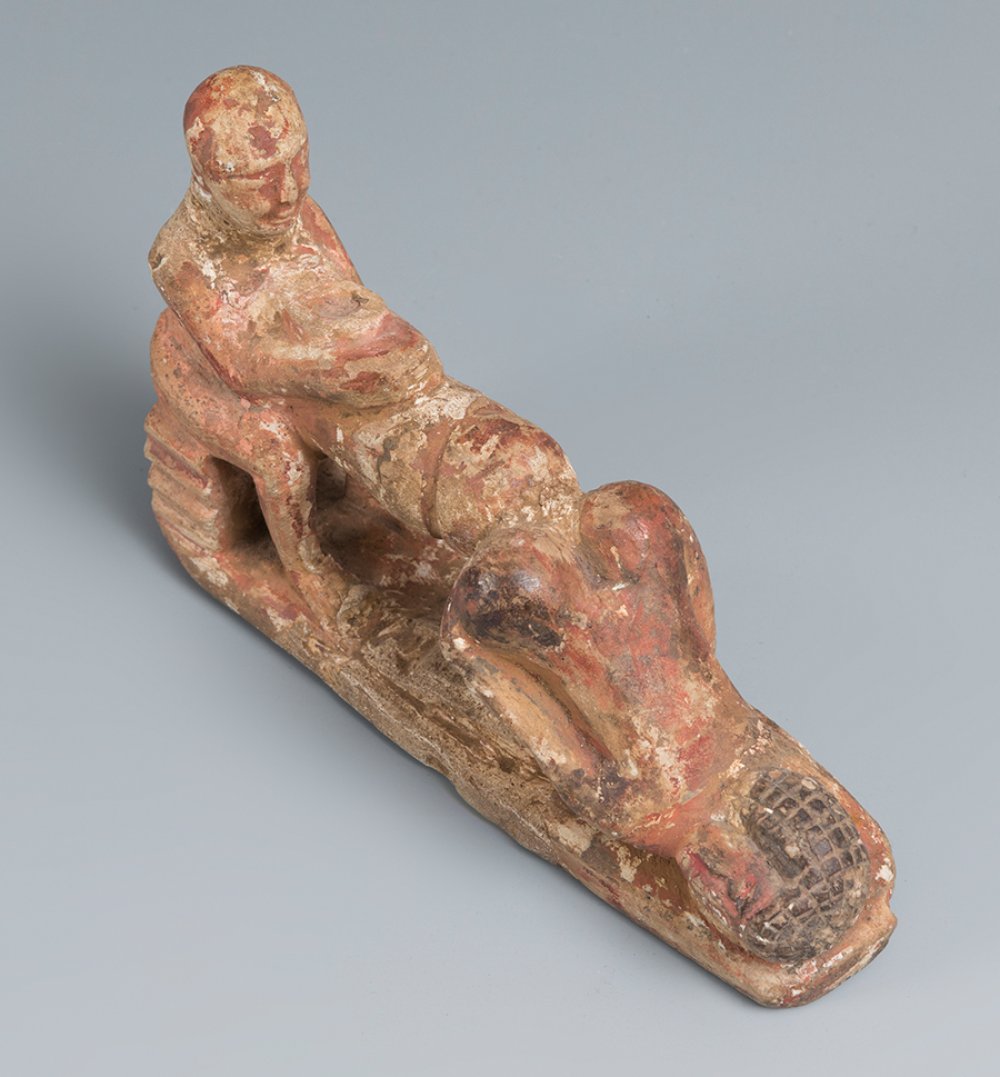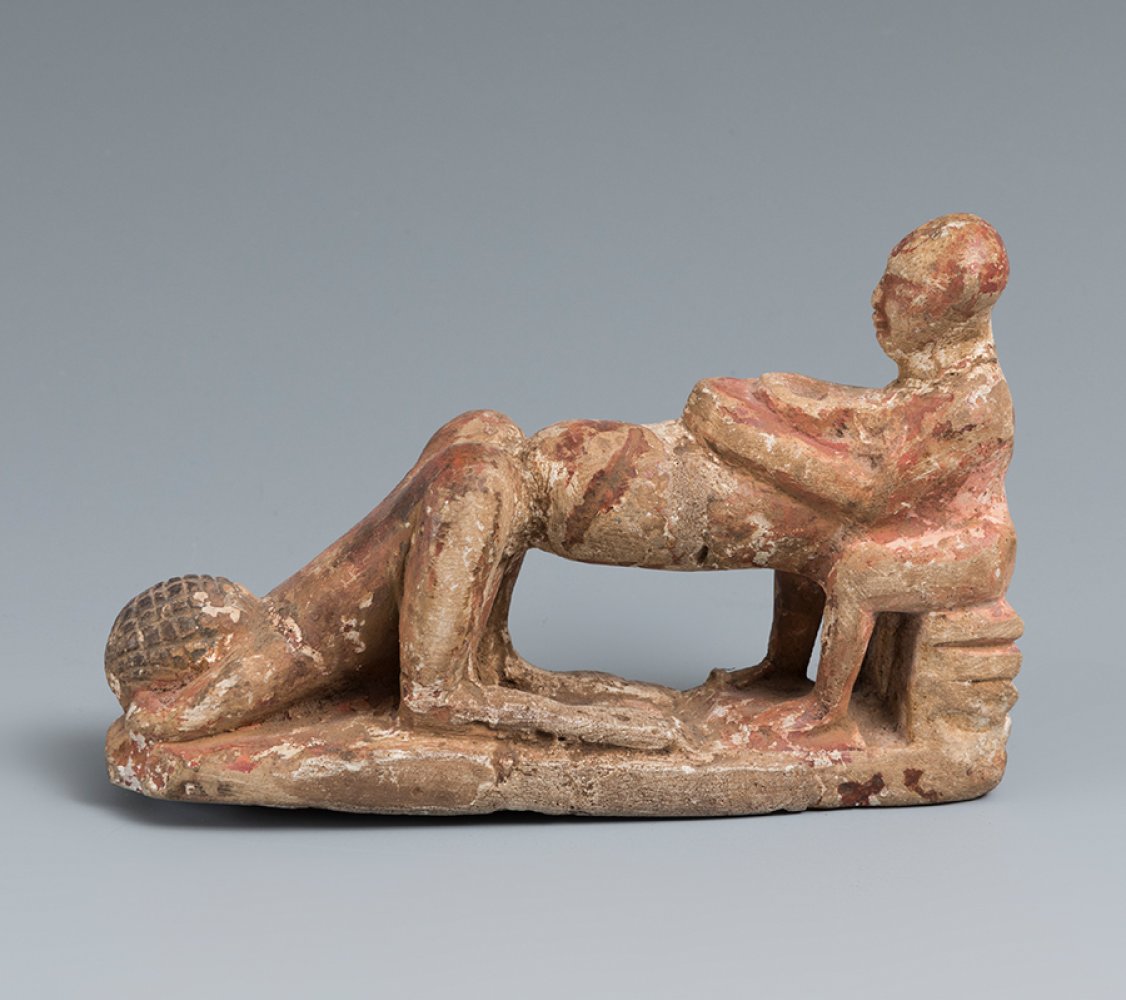5
Erotic scene. Ancient Egypt, Ptolemaic Period, 323-30 BC.Limestone.Good state of preservation.
Limestone.
Good state of preservation.
Provenance: Spanish private collection.
Measurements: 9.5 x 14 x 3 cm.
In the Ptolemaic period, erotic pieces proliferated in Greco-Egyptian sculpture. They often functioned as votive offerings, and numerous have been found in tombs. These figures can be linked not only to eroticism, but also to fertility and prosperity, as well as to the god Min, represented as ithyphallic (with a large erect phallus). An ithyphallic is an amulet that preserved from certain evils. It was used for this purpose by the emperors and was placed on their triumphal chariots. The god Min was one of the oldest Egyptian deities, coming from the Copts, for whom he was the protector of travellers and merchants. Min was a lunar god and ensured abundance. Legend has it that, because he was missing a leg, he was unable to go to war. Left alone with the women, he got them all pregnant. On his return, the men punished him, but later turned him into two because they realised that he had ensured the offspring of the people with his sexual disaffection.
The Ptolemaic dynasty is the dynasty founded by Ptolemy I Soter, general of Alexander the Great. This dynasty ruled Egypt during the Hellenistic period from the death of Alexander until 30 BC, when it became a Roman province. It is also known as the Lagid dynasty, after the name of Ptolemy I's father (or presumed father) Lagos. Ptolemy I established the capital of this kingdom in Alexandria, a small town at the time that became the main commercial and intellectual centre of antiquity. This dynasty adopted Egyptian customs from the beginning and was a constant enemy of the Macedonian Seleucid dynasty. It was during the reign of one of its monarchs (Ptolemy V) that a decree was published (in 197 BC) in three types of writing on a black stone known today as the Rosetta Stone. At some points in its history, the dynasty dominated Cyrenaica (northeast of present-day Libya), as well as southern Canaan and Cyprus.
Its last ruler was the famous Cleopatra. After her death and that of her son, Caesarion (Ptolemy XV), the dynasty ended and Egypt was annexed by Augustus to the Roman Empire.
Limestone.
Good state of preservation.
Provenance: Spanish private collection.
Measurements: 9.5 x 14 x 3 cm.
In the Ptolemaic period, erotic pieces proliferated in Greco-Egyptian sculpture. They often functioned as votive offerings, and numerous have been found in tombs. These figures can be linked not only to eroticism, but also to fertility and prosperity, as well as to the god Min, represented as ithyphallic (with a large erect phallus). An ithyphallic is an amulet that preserved from certain evils. It was used for this purpose by the emperors and was placed on their triumphal chariots. The god Min was one of the oldest Egyptian deities, coming from the Copts, for whom he was the protector of travellers and merchants. Min was a lunar god and ensured abundance. Legend has it that, because he was missing a leg, he was unable to go to war. Left alone with the women, he got them all pregnant. On his return, the men punished him, but later turned him into two because they realised that he had ensured the offspring of the people with his sexual disaffection.
The Ptolemaic dynasty is the dynasty founded by Ptolemy I Soter, general of Alexander the Great. This dynasty ruled Egypt during the Hellenistic period from the death of Alexander until 30 BC, when it became a Roman province. It is also known as the Lagid dynasty, after the name of Ptolemy I's father (or presumed father) Lagos. Ptolemy I established the capital of this kingdom in Alexandria, a small town at the time that became the main commercial and intellectual centre of antiquity. This dynasty adopted Egyptian customs from the beginning and was a constant enemy of the Macedonian Seleucid dynasty. It was during the reign of one of its monarchs (Ptolemy V) that a decree was published (in 197 BC) in three types of writing on a black stone known today as the Rosetta Stone. At some points in its history, the dynasty dominated Cyrenaica (northeast of present-day Libya), as well as southern Canaan and Cyprus.
Its last ruler was the famous Cleopatra. After her death and that of her son, Caesarion (Ptolemy XV), the dynasty ended and Egypt was annexed by Augustus to the Roman Empire.
10th November - Ancient Art
Sale Date(s)
Venue Address
General delivery information available from the auctioneer
Setdart offers Worldwide shipping
PICK UP IN ROOM: You can come and pick up your lots in our offices (Barcelona, Madrid or Valencia). At the moment of the withdrawal, you will be able to accept the current conditions of the lot by means of a document that you will sign.
YOU CAN SEND ANOTHER PERSON TO PICK UP: This person must present a signed authorization that you can find in our web page by accessing from BUY AT SETDART- LOGISTICS-DOWNLOAD AUTHORIZATION DOCUMENT. You can also send an e-mail with the requested data in AUTHORIZATION DOCUMENT to admin@setdart.com
Important Information
25% buyer´s premium
Terms & Conditions
The maximum period to pay the lots is 7 working days. You can pay either via bank transfer or with credit card through our platform www.setdart.com (we only accept VISA or Mastercard).
BUYER´S PREMIUM: 22% Hammer price + 21% VAT from the buyer´s premium
If your piece has more than 100 years, our Ministry of Culture requires an export certificate in order for the piece to leave the country. Note that if the piece goes inside the EU, there is no cost for the export certificate. If the piece goes outside the EU, there is a cost for the export certificate. You can find more information in our Ministry of Culture website: https://www.culturaydeporte.gob.es/en/cultura/patrimonio/exportacionimportacion/exportacion/tasas.html
INQUIRIES: admin@setdart.com
Setdart guides you through the entire process, from the time of award to the day you receive your lot. Our logistics team will be happy to manage your transport, and will advise you on the best shipping method with professionals from the sector used to handling works of art and jewelry.
WE OFFER WORLDWIDE DOOR TO DOOR SHIPPING
PICK UP IN ROOM: You can come and pick up your lots in our offices. At the moment of the withdrawal, you will be able to accept the current conditions of the lot by means of a document that you will sign.
YOU CAN SEND ANOTHER PERSON TO PICK UP: This person must present a signed authorization that you can find in our web page by accessing from BUY AT SETDART-LOGISTICS-DOWNLOAD AUTHORIZATION DOCUMENT. You can also send an e-mail with the requested data in AUTHORIZATION DOCUMENT to admin@setdart.com
SETDART IS NOT RESPONSIBLE FOR THE STATE OF THE PARTS ONCE THEY LEAVE OUR FACILITIES. MRW SHIPMENTS: Once the payment is made, your lot will be packed for shipment, the logistics department will send you an e-mail notifying you of the day it leaves our warehouse, changes of address cannot be made after receiving this e-mail.
INSURANCE INCIDENTS: Coverage for the value of the auction up to 3000 ? per shipment, if the value of the auction is higher, Setdart will send you a quote including the additional insurance. The insurance company WILL NOT BE RESPONSIBLE FOR THE SHIPMENT THAT EXCEEDS THAT AMOUNT AND IS NOT FULLY INSURED. MRW INCIDENTS: Maximum notification 48 hours after receipt, after which the insurance company WILL NOT BE RESPONSIBLE AND NO CLAIMS WILL BE ACCEPTED.
E-MAIL LOGISTICS: logistica@setdart.com
PICK UP YOUR MESSAGES: You can send your own messaging, prior notice via e-mail that your shipment is ready, please note 3 or 4 days in advance. This type of shipment is packaged so Setdart will provide you with a quote.
EXPENSES FOR STORAGE: We inform you that if the purchased lot is not picked up within a month, you will be charged 30€ per week per lot. Setdart Online S.L., owner of the web site "setdart.com", "setdart.net" and "setdart.org", acts as a company of Spanish nationality inscribed in the Volume 36955, sheet 182, page B-293056 of the Mercantile Registry, with registered office at Calle Aragó












